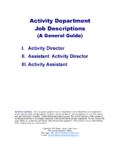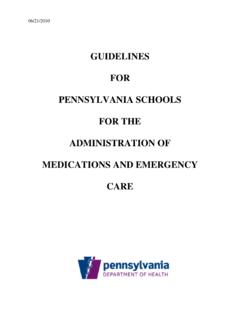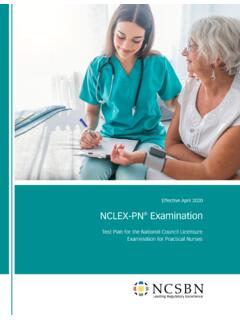Transcription of Example of a Well-Designed Course in: NURSING
1 Website: Example of a Well-Designed Course in: NURSING . 1. Specific Context The subject matter: NURSING The title of the Course : Community Health Promotion . Typical class size: 30 (Seniors, NURSING majors). Level of the Course : Upper Division Mode of delivery: o Blend of Lecture, online, clinical o 2 hrs lecture per week [2 cr. Hrs], 96 hrs clinical [2 hrs credit]. Type of institution: o Small liberal arts college with a total undergraduate NURSING enrollment of 460. 2. General Description of the Course Students synthesize knowledge based on principles of community health practice and epidemiology with a primary prevention focus. Delivering population based care for both communities and families is explored. The structure of the American Healthcare System is examined. Delivering NURSING care to aggregate/vulnerable populations within the community is also discussed.
2 (16 weeks). 3. Big Purpose of the Course To get NURSING students excited about providing population-based health promotion. 4. Important Situational Factors/Special Pedagogical Challenge Context 28- 30 senior undergraduate NURSING students Hybrid Course meeting for 2 hours every other week Nature of the subject Health focus on prevention rather than cure Not acute care focused Involves little use of technical NURSING skills . Characteristics of learners Full-time students Student enrollment mandatory to complete NURSING program Students will probably not know a lot about community health Students will be used to lecture style 1. Characteristics of teachers One Course director and 2 clinical faculty Background in community health promotion Fourth time teaching this Course for Course director. first time in Course for clinical faculty Clinical groups have 9 10 students each which are then broken into smaller groups of 4- 5 students.
3 The Course director will teach this Course many times in the future High level of competence, Course director is Certified Health Education Specialist, clinical faculty currently working in community health settings Special pedagogical challenges Challenge: Students may be only extrinsically motivated to learn the material in order to get a good grade in the class. They may have already decided on a specialty area of NURSING practice for their future and feel community health has no relevance for them First time Course is being offered as a hybrid This is the first time most students will not have lecture and PowerPoint presentation every week Response: I introduced the new Course design as an effort on my part to better meet student needs and used Dee Fink's suggested format for introducing the Course You can read the textbook on your own but you will need help learning how to apply information which is the focus of the Course .
4 2. 5. 3-Column Table Learning Goals: Assessment Activities: Learning Activities: Foundational Knowledge: 1. Quizzes 1. Small group discussion 1. Identify the foundations of 2. Discussion boards 2. Epi problem worksheets community health. a. Understand the eras in 3. Community GI outbreak 3. Assigned chapters and the historical case study articles development of 4. Elsevier community health 4. Lecture community health. specialty exam b. Explain the basic principles of epidemiology. c. Explain how community health can utilize health policy and law to improve the health of populations. d. Describe the basic organization of health systems in the Application: 1. Quizzes 1. Group discussions 2. Apply the essentials of 2. Discussion boards 2. Community windshield community health in your NURSING survey practice.
5 3. Critique of health a. Assess health protective education brochures used 3. Community assessment factors, predictive factors, at clinical agencies for their exercise beliefs, values, attributes and literacy appropriateness for 4. Video The Healing of practices of individuals, clients served America . families, communities and 4. Community analysis paper populations. 5. Health promotion program b. Use evidence based health 5. clinical community evaluation exercise promotion practices to analyze the advantages and 3. disadvantages of potential health promotion interventions. c. Use community assessment data and health program evaluation results to determine health priorities. d. Apply principles (access, quality and cost) for evaluating the quality of an existing health delivery system to that of a different health delivery system.
6 Integration: 1. Quizzes 1. Small group discussion 3. Integrate ability to promote and 2. Discussion boards 2. Lecture protect the health of vulnerable populations into your practice. 3. Development of health 3. Triage exercise a. Judge the impact of promotion program for 4. Class debate: All tobacco chronic/communicable vulnerable population products should be banned disease on morbidity, served in clinical in the US. mortality and approaches to 4. Critique of Thank you for prevention. Smoking or Enemy of the b. Integrate clinical judgment and decision-making skills in People . appropriate, timely NURSING care during disaster, mass casualty and other emergency situations. c. Identify the different roles community health plays in addressing the needs of vulnerable populations related to health disparities versus health inequities.
7 4. Human Dimension: 1. Discussion boards 1. Group discussion 4. Monitor and assess development 2. Learning portfolio 2. Reader theater's script . of your competence as a Death by Chocolate . community health nurse. a. Advocate for social justice. b. Articulate their reasons for valuing health promotion/prevention over cure. c. Get excited about how community health can utilize social and behavioral interventions to improve the health of populations. Caring: 1. Development of health 1. Group discussion 5. Demonstrate your ability to care education lesson plan on 2. Key informant interviews for the community as client. health risk factor(s) for a. Advocate for social justice. 2. Poster sessions of health b. Articulate their reasons for promotion programs valuing health promotion/ developed prevention over cure.
8 3. Discussion boards c. Get excited about how community health can utilize social and behavioral interventions to improve the health of populations. Learning How to Learn: 1. Development of personal 1. Small group discussion political advocacy plan 6. Continue self-learning about community health after Course ends. 2. Learning Portfolio a. Implement a personal plan to become politically active. b. Identify important information resources needed to apply 5. community health principles and tools to a new health problem. My biggest challenge was limiting the number of Course objectives. This was a good exercise as it forced me to really focus on what I wanted the students to walk away from the Course remembering. I had never thought about the human dimension, caring and learning how to learn taxonomies related to Course design which is ironic as NURSING is all about caring for humans.
9 The Course activities and assessments flowed easily from the objectives. It did require some thought since this had not been the previous focus of the Course . As I was freed from the tyranny of a lecture format for the Course , it was easy to think of many options. Once again, the challenge was to limit the number of activities and assessments. I. knew students had to learn basic community health concepts in order to pass NCLEX for their licensure. I included biweekly quizzes to ensure the students were reading and absorbing basic content. I also used the community health specialty exam by Elsevier at the end of the Course . The part I liked least about re-designing assessments was developing new grading rubrics. 6. Weekly Schedule This Course was a combination of in class and online interactions, along with clinical assignments.
10 Here is the schedule of activities for the Course . Meet N459. Course . OUTLINE. Room Sept 1 All Activity CLINCIAL. 308 Week 1 Goal Assessments Activities are due on the class Assignments Intro and HX of Community Required date. Health Identify eras in the historical One minute Assigned readings: Chap 1 and 2 and development of public health and paper 3. ways that community health affects literature, arts , current events and In class: Review syllabus and Course everyone's daily life. format 6. Intro lecture on team based learning and Course design for significant learning. Online Sep 8 All Activity Week 2 Goal Assessments Epidemiology (Epi) Required Explain the basic principles of Background Required: epidemiology including: rates, risk knowledge Assigned readings: Chap 7. factors, disease determinants, probe Epi worksheet due causation, surveillance/investigation, Discussion prevalence, incidence, morbidity and board due.






![Community/Public Health Nursing [C/PHN] Competencies …](/cache/preview/6/f/2/d/3/5/8/1/thumb-6f2d3581a8f58cb69460511e5a955964.jpg)



